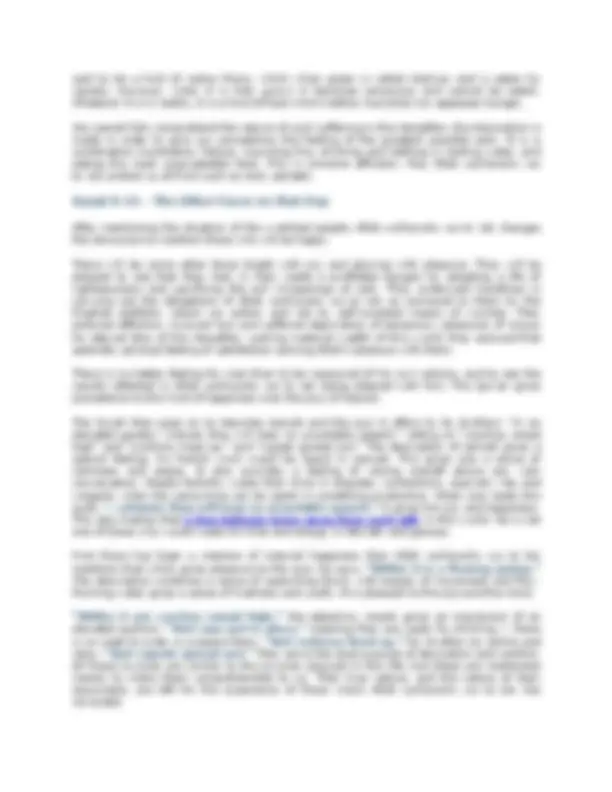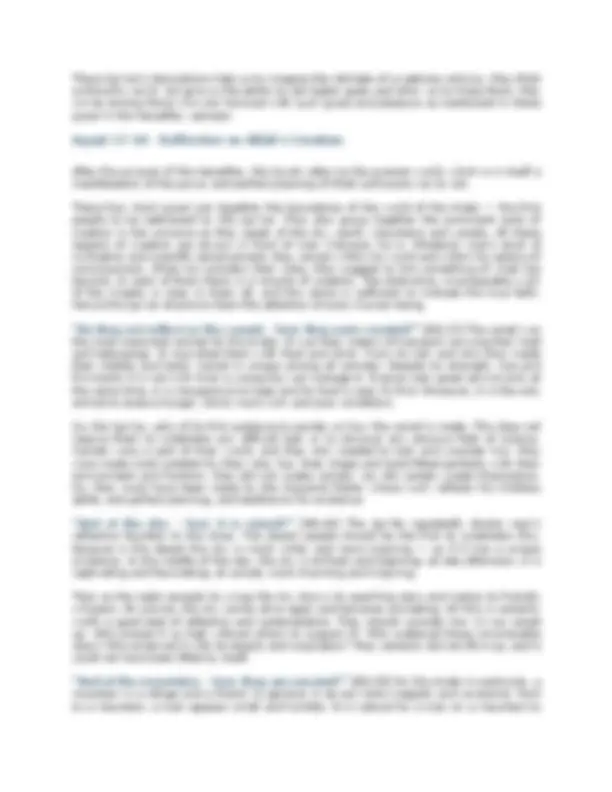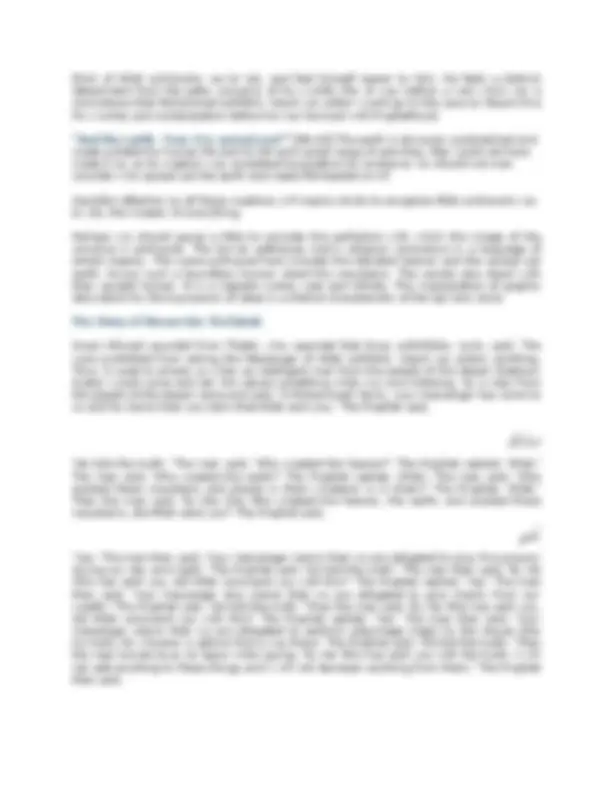





Study with the several resources on Docsity

Earn points by helping other students or get them with a premium plan


Prepare for your exams
Study with the several resources on Docsity

Earn points to download
Earn points by helping other students or get them with a premium plan
Community
Ask the community for help and clear up your study doubts
Discover the best universities in your country according to Docsity users
Free resources
Download our free guides on studying techniques, anxiety management strategies, and thesis advice from Docsity tutors
This Surah invites man to meditation, hope and fear; meditation over where he is heading; hope of the bliss of Jannah and fear of the Hellfire.
Typology: Schemes and Mind Maps
1 / 6

This page cannot be seen from the preview
Don't miss anything!




This Surah invites man to meditation, hope and fear; meditation over where he is heading; hope of the bliss of Jannah and fear of the Hellfire. Starting with, “Has there reached you the report of the Enveloper,” it warns man to come out of his heedlessness and be ready for the Day of Reckoning called Ghashiyah [the Enveloper] in this Surah. This name suggests that a calamity will befall mankind and envelop them with its horrors. It is one of the many evocative names mentioned in the Surahs in this Juz.
Immediately after this inquisition details of the impending calamity are given as to how the people will be divided into two separate groups and will meet separate ends. One group of the people will go to Hell and they will suffer punishment; the second group will go to the Paradise and will be provided with, blessings.
After thus arousing the people the theme suddenly changes and the question is asked: Do not these people, who frown and scorn the teaching of Tawheed, observe the common things which they experience daily in their lives? Do they never consider how the camels, on whom their life depends in the Arabian desert, came into being, endowed precisely with the same characteristics as were required for the beast needed in their desert life? When they go on their journeys, they see the sky, the mountains, or the earth. Let them ponder over these three phenomena and consider as to how the sky was stretched above them, how the mountains were erected and how the earth was spread beneath them? Has all this come about without the skill and craftsmanship of an All- Powerful, All Wise Designer?
After making the truth plain by this concise and rational argument, the address turns from the disbelievers to the Prophet salAllahu ‘alayhi wa sallam and he is told if these people do not acknowledge the truth then you are not responsible for their refutation. You have not been empowered to act with authority over them, so that you should coerce them into believing: your only task is to exhort, so exhort them. Ultimately they have to return to Allah subhanahu wa ta`ala ; then He will call them to full account and shall inflict a heavy punishment on those who do not believe.
The Surah opens with a question followed by a story related to it. The scene of suffering and torture is given before the scene of joy, because the former is closer to the connotations of the name given to the event, the Enveloper.
We are being told that on that Day there will be faces which will look downcast and worn out. Why has the faced been mentioned here? It is because face is a reflection of one’s internal condition. People who are at peace and happy, they have radiant and glowing faces. On the other hand, unhappy people have visible signs of depression and stress on their face. Who will be these people with downcast and worn out faces? They belong to people who have labored and toiled without satisfactory results. In Surah al-Layl, we read about people’s diverse efforts in this world. One is toiling to accumulate the worldly pleasures of this temporary world while the other is exhausting himself to gain the pleasure of Allah subhanahu wa ta`ala. When the efforts are diverse then certainly the results will be different too. The one who is toiling for the pleasures of this world his efforts will be a total loss, and it will give him nothing more than disappointment, humiliation and exhaustion.
Moreover, man’s efforts not only differ on worldly matters but also on religious matters. There are people who have invented things in religion which were not followed or taught by Rasooullah salAllahu ‘alayhi wa sallam. People are exhausting themselves over self-invented strenuous methods of worship such as reciting a certain dhikr 1000 times at a certain time, or staying awake all night on a special day of the week missing fard Salah the next day. They are laboring and wearing themselves out for something other than what Allah subhanahu wa ta`ala ordained.
Al-Hafiz Abu Bakr Al-Burqani narrated from Abu Imran Al-Jawni that he said, “Umar bin Al-Khattab passed by the monastery of a monk and he said, ‘O monk!’ Then the monk came out, and Umar looked at him and began to weep. Then it was said to him, ‘O Commander of the faithful! Why are you weeping?’ He replied,I remembered the statement of Allah, the Mighty and Majestic, in His Book,
[Laboring, weary. They will enter into Fire, Hamiyah.] So that is what has made me cry.’” [Tafseer ibn Katheer]
The work of these people was totally for themselves and their families, for their own ambitions in the life of this world. Then they come to reap the fruits of their toil, not having made any provision for their future life. Hence they face the end with a mixture of humiliation, exhaustion, misery and hopelessness. In addition to all this they roast “in an intensely hot Fire,” they will be given “drink from a boiling spring,” their food will be “poisonous thorny plant which will neither nourish nor satisfy their hunger.”
The Arabic term dari’ , has been translated here as ‘poisonous, dry thorns’. Some commentators say that it refers to a tree of fire in hell. This explanation is based on what has been revealed about the tree of zaqqoom which grows at the centre of hell. It is also
These Qur’anic descriptions help us to imagine the ultimate of sweetness and joy. May Allah subhanahu wa ta`ala give us the ability to set higher goals and allow us to chase them. May we be among those who are honored with such grace and pleasure as mentioned in these ayaat in the Hereafter, aameen.
After the account of the Hereafter, the Surah refers to the present world, which is in itself a manifestation of the power and perfect planning of Allah subhanahu wa ta`ala.
These four short ayaat join together the boundaries of the world of the Arabs — the first people to be addressed by the Qur’an. They also group together the prominent ends of creation in the universe as they speak of the sky, earth, mountains and camels. All these aspects of creation are always in front of man wherever he is. Whatever man’s level of civilization and scientific advancement, they remain within his world and within his sphere of consciousness. When he considers their roles, they suggest to him something of what lies beyond. In each of them there is a miracle of creation. The distinctive, incomparable work of the Creator is clear in them all, and this alone is sufficient to indicate the true faith. Hence the Qur’an directs to them the attention of every human being.
“Do they not reflect on the camels - how they were created?” [88:17] The camel was the most important animal for the Arabs. It was their means of transport carrying their load and belongings. It nourished them with food and drink. From its hair and skin they made their clothes and tents. Camel is unique among all animals. Despite its strength, size and firm build, it is not wild. Even a young boy can manage it. It gives man great service and, at the same time, it is inexpensive to keep and its food is easy to find. Moreover, it is the only animal to endure hunger, thirst, hard work and poor conditions.
So, the Qur’an, asks of its first audience to ponder on how the camel is made. This does not require them to undertake any difficult task or to discover any obscure field of science. Camels were a part of their world, and they only needed to look and consider how they were made most suitable for their role; how their shape and build fitted perfectly with their environment and function. Man did not create camels, nor did camels create themselves. So, they must have been made by the Supreme Maker whose work reflects His limitless ability and perfect planning, and testifies to His existence.
“And at the sky – how it is raised?” [88:18] The Qur’ān repeatedly directs man’s reflective faculties to the skies. The desert people should be the first to undertake this, because in the desert the sky is much richer and more inspiring — as if it has a unique existence. In the middle of the day, the sky is brilliant and beaming; at late afternoon, it is captivating and fascinating; at sunset, most charming and inspiring.
Then as the night spreads its wings the sky shows its sparkling stars and makes its friendly whispers. At sunrise, the sky comes alive again and becomes animating. All this is certainly worth a good deal of reflection and contemplation. They should consider how it was raised up. Who placed it so high without pillars to support it? Who scattered those innumerable stars? Who endowed it with its beauty and inspiration? They certainly did not lift it up, and it could not have been lifted by itself.
“And at the mountains – how they are erected?” [88:19] For the Arabs in particular, a mountain is a refuge and a friend. In general, it always looks majestic and awesome. Next to a mountain, a man appears small and humble. It is natural for a man on a mountain to
think of Allah subhanahu wa ta`ala , and feel himself nearer to Him. He feels a distinct detachment from the petty concerns of his worldly life. It was neither a vain whim nor a coincidence that Muhammad salAllahu ‘alayhi wa sallam would go to the cave on Mount Hira for worship and contemplation before he was honored with Prophethood.
“And the earth - how it is spread out?” [88:20] The earth is obviously outstretched and made suitable for human life and its full and varied range of activities. Man could not have made it so, as its creation was completed long before his existence. So should not man consider who spread out the earth and made life feasible on it?
Sensible reflection on all these creations will inspire minds to recognize Allah subhanahu wa ta`ala , the Creator of everything.
Perhaps we should pause a little to consider the perfection with which this image of the universe is portrayed. The Qur’an addresses man’s religious conscience in a language of artistic beauty. The scene portrayed here includes the elevated heaven and the spread out earth. Across such a boundless horizon stand the mountains. The camels also stand with their upright humps. It is a majestic scene, vast and infinite. This manipulation of graphic description for the expression of ideas is a distinct characteristic of the Qur’anic style.
The Story of Dimam bin Tha’labah
Imam Ahmad recorded from Thabit, who reported that Anas radhiAllahu ‘anhu said, “We were prohibited from asking the Messenger of Allah salAllahu ‘alayhi wa sallam anything. Thus, it used to amaze us when an intelligent man from the people of the desert (bedouin Arabs) would come and ask him about something while we were listening. So a man from the people of the desert came and said, ‘O Muhammad! Verily, your messenger has come to us and he claims that you claim that Allah sent you.’ The Prophet said,
‘He told the truth.’ The man said, ‘Who created the heaven?’ The Prophet replied, ‘Allah.’ The man said, ‘Who created the earth?’ The Prophet replied, ‘Allah.’ The man said, ‘Who erected these mountains and placed in them whatever is in them?’ The Prophet, ‘Allah.’ Then the man said, ‘By the One Who created the heaven, the earth, and erected these mountains, did Allah send you?’ The Prophet said,
‘Yes.’ The man then said, ‘Your messenger claims that we are obligated to pray five prayers during our day and night.’ The Prophet said, ‘He told the truth.’ The man then said, ‘By He Who has sent you, did Allah command you with this?’ The Prophet replied, ‘Yes.’ The man then said, ‘Your messenger also claims that we are obligated to give charity from our wealth.’ The Prophet said, ‘He told the truth.’ Then the man said, ‘By He Who has sent you, did Allah command you with this?’ The Prophet replied, ‘Yes.’ The man then said, ‘Your messenger claims that we are obligated to perform pilgrimage (Hajj) to the House (the Ka`bah), for whoever is able to find a way there.’ The Prophet said, ‘He told the truth.’ Then the man turned away to leave while saying, ‘By He Who has sent you with the truth, I will not add anything to these things and I will not decrease anything from them.’ The Prophet then said,